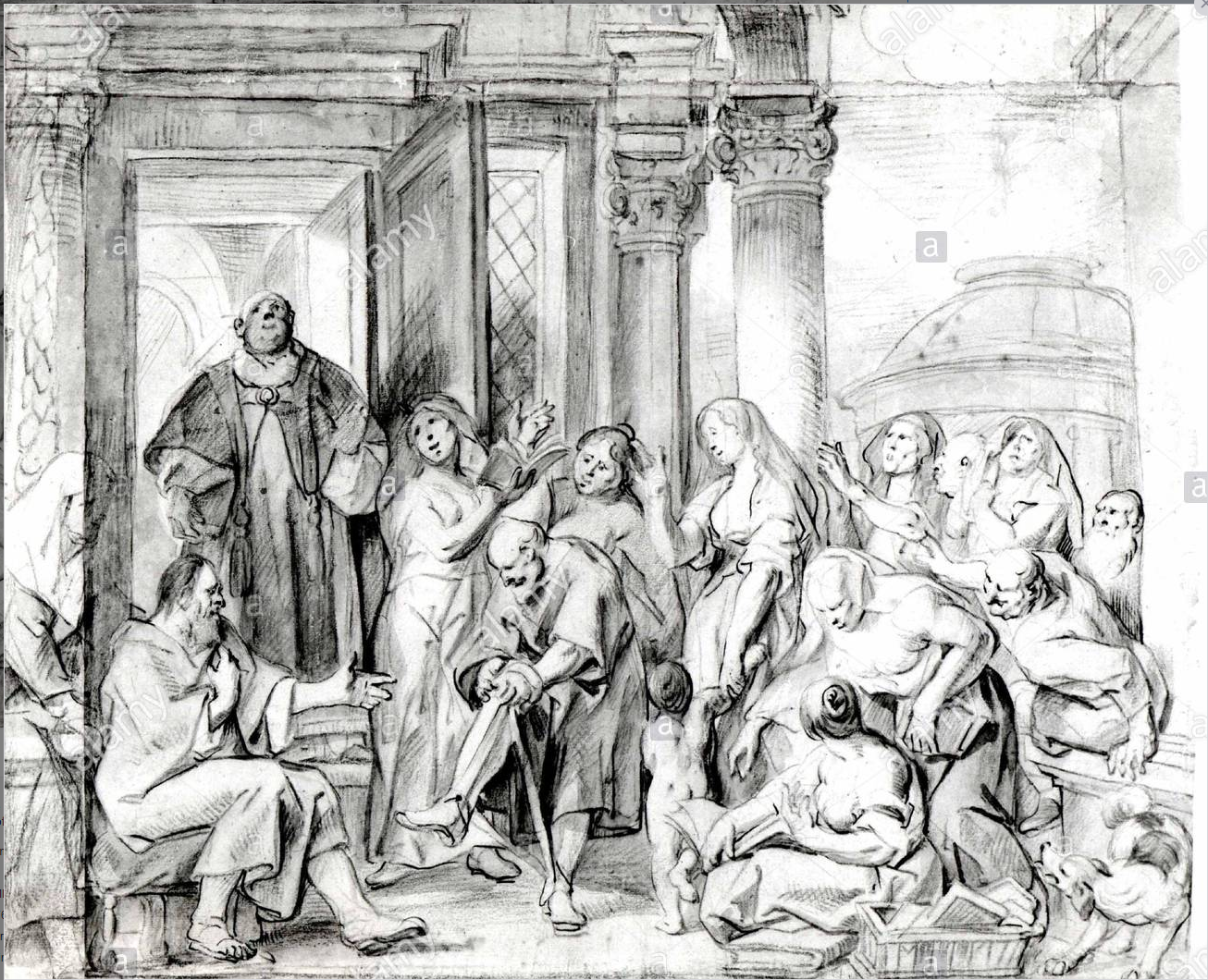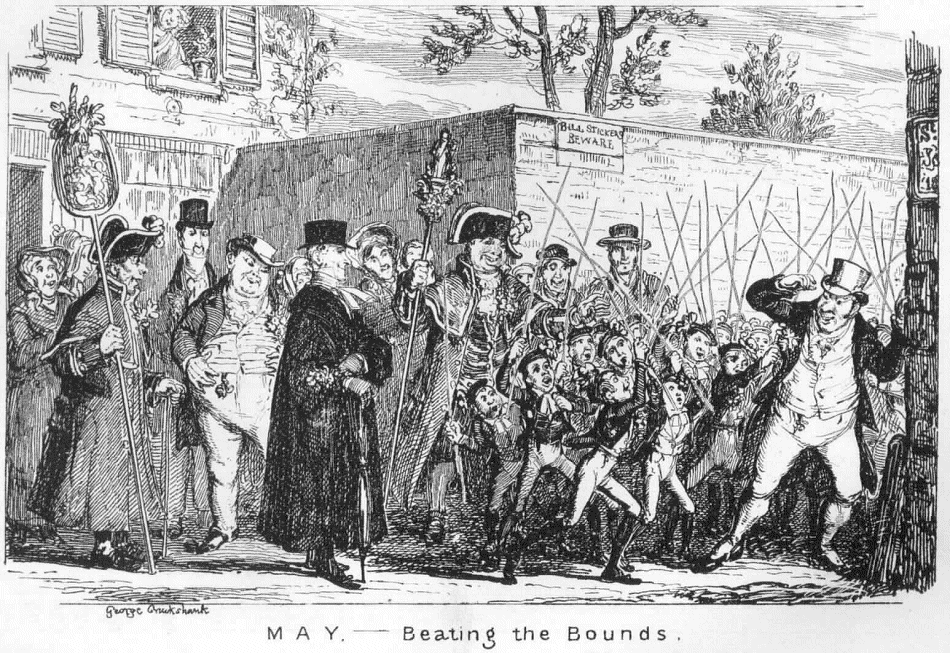This mass will be livecast at 10 A.M. Sunday May 17, 2020.
Here is the program.
The apostle Philip healing a cripple in Samaria.
Jacob Jordaens (Flemish, Antwerp 1593-1678)
Mount Calvary Church
A Roman Catholic Parish
The Personal Ordinariate of the Chair of St. Peter
Baltimore, Maryland
Rev. Albert Scharbach, Pastor
Dr. Allen Buskirk, Choir Director and Cantor
Midori Tanaka, Organist
May 17, 2020
10 A.M. Livecast on YouTube
Easter VI
Rogation Sunday
______________________
Organ Prelude
Voluntary II by William Boyce
__________
Organ Postlude
Hyfrydol, arranged by Charles Callahan
__________________
Common
Missa de S. Maria Magdalena, H. Willan
__________________
Anthems
Rise up, my love, Healey Willan (1880-1968)
Rise up, my love, my fair one, and come away; for lo, the winter is past, the rain is over and gone; the flowers appear upon the earth; the time of the singing of birds is come. Arise my love, my fair one, and come away.
The text for today’s offertory anthem “Rise up my love, my fair one” is taken from that strange and beautiful book dwelling almost exclusively on romantic love, the Song of Solomon. Although the origin of this book is obscure, perhaps coming from the ancient Israelite marriage liturgy, it was read very early on as an allegory of God’s love for Israel and in the Christian era as Christ’s love for the church. “Rise up my love, my fair one,” can be heard equally plausibly as Christ offering redemption to the sinner or as the blossoming of new hope through forgiveness at a turning point in a romantic relationship. Healey Willan (1880-1968) was born in England and attended a choir school where he studied harmony, counterpoint, and organ. From an Anglo-Catholic background, he became an authority on plainchant in English translation and many of his compositions have chant-like melodies with free meter.
__________
If ye love me, Thomas Tallis (1510-1585)
If ye love me, keep my commandments, and I will pray the Father, and he shall give you another comforter, that he may abide with you forever; even the spirit of truth.
“If Ye Love Me” is a setting for an a cappella choir of four voice parts, and it is a noted example of Reformation compositional style, essentially homophonic but with some elaboration and imitation. Typically for Anglican motets of this period, it is written in an ABB form, with the second section repeated.
The anthem was chosen to be sung when Pope Benedict XVI attended Evensong at Westminster Abbey during his 2010 visit to the United Kingdom, and also at the wedding of Prince Harry and Meghan Markle at St George’s Chapel, Windsor Castle in 2018
_________________
Hymns
Love’s redeeming work is done (SAVANNAH) by Charles Wesley is a cento composed of stanzas from his hymn “Christ the Lord is risen to-day.” Books originating in the Church of England tradition use the tune SAVANNAH, first found in England in John Wesley’s A Collection of Tunes, Set to Music, as they are commonly sung at the Foundery (1742), with the name HERNHUTH, which indicates its origins in 18th-century Moravian books. The name SAVANNAH comes from the Moravian settlement at Savannah, Georgia. Wesley accompanied the Moravians on their voyage from England to Savannah and was deeply impressed by their calm and faith during a storm that panicked the sailors.
__________
Alleluia! sing to Jesus (HYFRYDOL) was written by William Chatterton Dix (1837—1898). Revelation 5:9 describes this eschatological scene of joy and glory: “And they sang a new song, saying: ‘You are worthy to take the scroll and to open its seals, because You were slain, and with Your blood You purchased for God members of every tribe and language and nation.’” Dix invites us to sing that new song of praise to our ascended Savior. This hymn is a declaration of Jesus’ victory over death and His continued presence among His people. By complex and interlocking allusions to Scripture, it presents a very high view of the Eucharist presence: Jesus is both “Priest and Victim” in this feast. Jesus, having triumphed over sin and death, “robed in flesh” has ascended above all the heavens, entering “within the veil” to the very throne of God. Dix sees in the Eucharist the fulfillment of Jesus’ promise to be with us evermore.
HYFRYDOL (the word means, ‘cheerful’ or ‘melodious’), by Rowland Huw Prichard (1811-1887) was set for three voices, there being still at that time those who thought that there was something improper in four-part singing. The tune is in the tenor until line 7, in which the tenor is silent and the melody is in the upper part. The tune shows some sophistication in its construction. The melody lies within a fifth (tonic to dominant) until, at the climax in the last line, it rises to the sixth degree. The repetition of the first two lines in lines 3 and 4, and the powerful sequential construction of line 5 (characteristic of Welsh hymn melodies) suggest, perhaps, that the larger structure will conform to the common AABA form, but this expectation is defeated by new material for lines 7 (which is also strongly sequential) and 8 (which draws on the sequential motif from line 5).
Rogation Days
In the year 470 a French bishop called for three days of prayer, fasting, and processions in order to protect his earthquake-ravaged diocese from further tremors. He scheduled these days of prayer and penance for the Monday, Tuesday, and Wednesday preceding Ascension Day (for more on penance, see Repentance). This observance spread throughout France and reached Rome around the ninth century. In Rome the pope combined these ceremonies with those already occurring on April 25. He mandated that the most important religious services take place on April 25 and the other, lesser services on the three days preceding the Ascension. English speakers call these four days of prayer and processions the Rogation Days. The word rogation comes from the Latin word rogare, meaning “ask” or “plead.” April 25 is known as the Major Rogation, and the other days as the Minor Rogations. St. Mark’s Day is also observed on April 25, although this observance is not related to the Rogation Days. In addition, although the Sunday before Ascension Day was not one of the original Rogation Days, the spirit of the Rogation Days influenced the way in which it was observed and inspired people to call it Rogation Sunday.
Beating the Bounds
In medieval England the Rogation Days were observed with processions that began in the local church and proceeded to outline the boundaries of the parish, pausing occasionally for the recitation of prayers. Priests and cross-bearers led these long walks in the countryside. Accordingly, the English sometimes called the Rogation Days the “Walking Days” from the Old Anglo-Saxon name for the observance, Gang Daegas, meaning approximately “Day of Going About.” They also called them the “Cross Days,” a reference to the cross carried at the head of the processions. Scholars trace the custom of prayerful perimeter-walking back to the Roman festival of Ambargalia, in which the Romans paced the perimeter of their fields asking the gods to bless them with fertility. In any case, those who participated in the Rogation Day walks were expected to fast before the procession, and to treat the event as a sober religious exercise rather than a holiday in the countryside. Nevertheless, people tended to turn the event into an expression of pride in their parish. On occasion, an excess of “team spirit” led some parish groups to attack others that they encountered.
After the Reformation some of Protestant denominations attempted to eliminate folk customs associated with the Rogation Days. In England Rogation processions were curtailed, though not completely eliminated. At a later date, however, people revived them. Some writers believe that the processions served an important social as well as religious function by teaching youth the parish boundary lines in an era when maps were not in common circulation. Youngsters accompanying the procession were often bumped against stone boundary markers, tossed into streams that divided one parish from another, or forced to climb hedges, walls, or even houses built over the boundary lines. Some writers speculate that this painful process gave rise to the folk name for the custom, “beating the bounds.” Presumably this ordeal left the boys with a permanent if somewhat unpleasant memory of the exact location of the parish boundaries. On the other hand, the name may come from the common custom of beating the boundary markers with wooden wands so as to impress their location upon the memory. Indeed some parish processions did not subject participants to painful ordeals other than the walk itself, which could be quite taxing. In many locations adults and children who took part in these excursions were rewarded with coins, sweets, fruit, nuts, bread, cheese, or ale along the way.
The beating of the bounds during the Rogation Days reached the height of its popularity around 1700 and then entered a long, slow decline. Folklorists attribute this decline to the enclosure of what had once been open fields, as well as waning belief in the effectiveness of the processions as a means of finding favor with God. In recent years these old Rogationtide processions have experienced a modest revival. Priests lead parish children in yearly Ascension Day processions in the university town of Oxford. In Chudleigh, near Exeter, ambitious parishioners beat the bounds of their parish every seven years. The expedition takes the party over a twenty-one-mile route, requiring at least one volunteer to swim the river Teign and the entire party to board a bus in order to cross a busy highway. The arduous nature of the task seems to have inspired the seven-year delay between processions.
The hobbits who beat the bounds of the Shire, as Tolkien explained, are called bounders.

